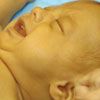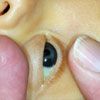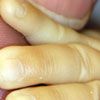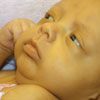Hemolytic Disease of the Newborn
An 8-week-old boy is brought for evaluation of gradually worsening yellow skin discoloration of about 1 week's duration. His parents report that he has had constipation for the past several days; before that, he had green diarrhea and occasionally spit up after breast-feeding.

The Case:
An 8-week-old boy is brought for evaluation of gradually worsening yellow skin discoloration of about 1 week's duration. His parents report that he has had constipation for the past several days; before that, he had green diarrhea and occasionally spit up after breast-feeding. The infant has been irritable and has been sleeping more often. He has had no fever, no change in eating habits or in the frequency of wet diapers, and no sick contacts.
He was born at 32 weeks' gestation via cesarean delivery to an Rh-negative mother with type A-negative blood. His birth weight was 1789 g. He received several intrauterine transfusions of O-negative blood for significant anemia noted on percutaneous umbilical blood sampling. After delivery, he was monitored in the neonatal ICU for 26 days and did not require further transfusions. At discharge, his parents were given an apnea monitor as a precaution.
The infant is awake and attentive on examination. Rectal temperature is 37°C (98.6°F); heart rate, 156 beats per minute; respiration rate, 48 breaths per minute; and oxygen saturation, 98% on room air. Scleral icterus and diffuse pallor and jaundice of the skin from head to toe are noted. Cardiac and pulmonary findings are unremarkable.
What is the most likely cause of this patient's symptoms?
• Hemolytic disease of the newborn
• Sepsis
• Glucose-6-phosphate dehydrogenase deficiency
• Crigler-Najjar syndrome
(Answer and discussion begin on next page)

Answer: Hemolytic disease of the newbornDiscussion: The differential diagnosis for infant jaundice can range from a normal process to a life-threatening infection or severe congenital abnormality. Physiological jaundice is caused by the inability of the immature liver to adequately conjugate bilirubin. This is an indirect hyperbilirubinemia that is not associated with anemia or other laboratory abnormalities. Physiological jaundice occurs on the second or third day of life, peaks around the fourth day, and resolves by the fifth or sixth day.
Jaundice is considered pathological if it occurs on the first day of life or after the third day of life or if it is associated with conjugated hyperbilirubinemia, anemia, abnormal vital signs, or an infectious process.1

The typical workup for infant jaundice comprises a thorough history, including birth history and family birthing history, and physical examination with a complete blood cell count, liver function testing, total and direct bilirubin measurement, and urinalysis. Urinalysis should be ordered because asymptomatic infants with jaundice are at elevated risk for urinary tract infections.2 If an infectious cause is suspected, blood cultures and cerebrospinal fluid analysis may be necessary. All patients with anemia should undergo a direct and indirect Coombs test, ABO/Rh typing, and a reticulocyte count.2
The incidence of kernicterus has decreased significantly because of the use of Rh immunoglobulin (eg, RhoGAM), aggressive phototherapy, and exchange transfusions. However, research suggests that it may be rising.3
Patients who have hemolytic anemia associated with hyperbilirubinemia or who have significant unconjugated hyperbilirubinemia (typically greater than 15 mg/dL) require hospitalization for further treatment.2 Patients with sepsis or any level of conjugated hyperbilirubinemia should also be admitted.

OUTCOME OF THIS CASE
This patient's hemoglobin level was 2.3 g/dL; hematocrit, 6.9%; white blood cell count, 7700/µL (with 19% segmented neutrophils, 4% lymphocytes, and 4% bands); platelet count, 194,000/µL; aspartate aminotransferase, 15 U/L; alanine aminotransferase, 36 U/L; and bilirubin, 13.7 mg/dL (total) and 1.3 mg/dL (direct). Urinalysis results were normal. Blood and urine cultures were negative. A chest radiograph showed no evidence of pneumonia.
Hemolytic disease of the newborn was diagnosed. The cause was thought to be Rh incompatibility; this autoimmune hemolytic anemia is characterized by hemolysis and unconjugated hyperbilirubinemia. Manifestations of this disease can range from mild asymptomatic anemia and hyperbilirubinemia (Figure) to hydrops fetalis and intrauterine death. Some patients require transfusions during both the prenatal and the early postnatal periods. This patient did not require further transfusions until 8 weeks after birth.
OTHER CAUSES OF HYPERBILIRUBINEMIA IN INFANTS
In patients with sepsis, an indirect hyperbilirubinemia occurs after the third day of life but before the first week of life. Signs of systemic illness include fever, lethargy, poor feeding, and dehydration.2 Conjugated hyperbilirubinemia is also common.
Glucose-6-phosphate dehydrogenase deficiency is an enzyme deficiency in the glycolysis pathway that causes hemolytic anemia. It is characterized by an increased indirect hyperbilirubinemia and a positive family history. Patients of Mediterranean, East Asian, and African descent are at higher risk for this disease.2
Crigler-Najjar syndrome is a life-threatening congenital abnormality that causes a decrease in bilirubin excretion by impaired conjugation. Patients with this syndrome have a defect in the bilirubin UDP-glucuronosyltransferase enzyme, which causes an increase in unconjugated bilirubin.2
References:
REFERENCES:
1.
Behrman RE, Kliegman RM, Jenson HB. Nelson Textbook of Pediatrics. 17th ed. Philadelphia: Saunders; 2003:592-596.
2.
Colletti JE, Kothori S, Jackson DM, et al. An emergency medicine approach to neonatal hyperbilirubinemia. Emerg Med Clin North Am. 2007;25:1117-1135, vii.
3.
Shapiro SM, Bhutani VK, Johnson L. Hyperbilirubinemia and kernicterus. Clin Perinatol. 2006;33:387-410.